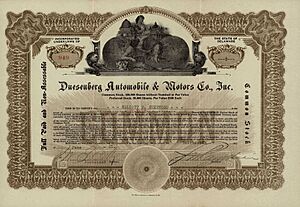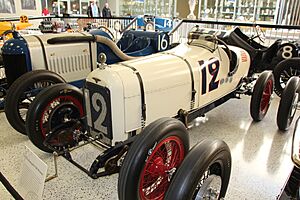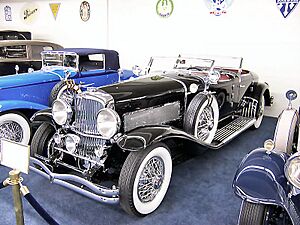Duesenberg facts for kids
 |
|
| Industry |
|
|---|---|
| Fate | Dissolved |
| Predecessor | Duesenberg Motors Company (1913–1919) |
| Founded | Indianapolis, Indiana, U.S. (1920) |
| Founders |
|
| Defunct | 1937 |
| Headquarters |
,
U.S.
|
|
Key people
|
|
| Products |
|
| Parent | Auburn Automobile Company |
Duesenberg Automobile & Motors Company, Inc. was an American company. It made both racing cars and fancy luxury cars. Brothers Fred and August Duesenberg started the company in Indianapolis, Indiana, in 1920.
Duesenberg is famous for making the "straight-eight engine" popular. They also made cars with four-wheel hydraulic brakes. A Duesenberg car was the first American car to win a Grand Prix race. This happened at the 1921 French Grand Prix. Duesenberg cars also won the Indianapolis 500 four times. They won in 1922, 1924, 1925, and 1927. A businessman named Errett Lobban Cord bought Duesenberg in 1926. The company was sold and closed down in 1937.
Contents
History of Duesenberg Cars
Fred and August Duesenberg started designing car engines in the early 1900s. Fred was interested in bicycle racing first. The brothers designed their first car in 1905. In 1906, they started the Mason Motor Car Company in Des Moines, Iowa. They got money from a lawyer named Edward R. Mason. Later, F. L. and Elmer Maytag bought most of the company. They changed its name to Maytag-Mason Automobile Company. They sold their part of the company in 1912.
The Duesenberg brothers then moved to Saint Paul, Minnesota. There, they started the Duesenberg Motors Company in 1913. The first Duesenberg-designed car raced at the Indianapolis 500 in 1914. It was driven by Eddie Rickenbacker and finished tenth. During World War I, the Duesenbergs designed and built airplane engines. They did this in Elizabeth, New Jersey. A Duesenberg car driven by Tommy Milton won the 1919 Elgin Trophy. In 1919, the brothers sold their factories in Saint Paul.
In 1920, the Duesenberg brothers moved to Indianapolis, Indiana. They started the Duesenberg Automobile & Motors Company there. They began making the Duesenberg Model A. The brothers focused on engineering. They let other people handle the business side of the company. The first Model A was ordered by a Hawaiian businessman. This car had a 260 cubic inch (4.3 L) straight-eight engine. It made 88 horsepower. This was the biggest engine in a car you could buy at the time. It was also the first car to have hydraulic brakes on all its wheels.
The company kept building race cars too. A Duesenberg driven by Jimmy Murphy won the 1921 French Grand Prix. This was a big win for an American car. Duesenberg cars also did very well at the Indianapolis 500. They won the race in 1922, 1924, 1925, and 1927.
The company faced money problems in 1924. It was then bought by Errett Lobban Cord in 1926. After Cord took over, August Duesenberg mostly worked on the racing cars. He designed all Duesenberg race cars from 1926 until the company closed. Two years later, Cord asked the Duesenbergs to make a new car. He wanted it to be better than all other American cars. In 1929, the company started selling the Duesenberg Model J. This car had a 265 horsepower straight-eight engine. The body and inside of the car were custom-built by special companies. These cars cost between $14,000 and $20,000 back then.
Duesenbergs were seen as some of the most luxurious American cars ever. They were popular with movie stars, royalty, and other rich people. The company was sold by Cord and closed down in 1937. The last Duesenberg car made by the original company was finished in 1940. It was ordered by a German artist. August Duesenberg finished it after the company had already closed.
In 1998, a company called The Franklin Mint started making small models. These were models of a made-up luxury car called the Duesenberg Coupé Simone.
Attempts to Bring Back Duesenberg
Several tries were made to bring back the Duesenberg name. August Duesenberg tried to restart the company in 1947, but it didn't work. His son, Fritz, and car designer Virgil Exner also tried in 1966. They made one concept car, but the plan failed. In 1970, Bernard Miller bought the Duesenberg Corporation. He made eight SSJ models between 1970 and 1974.
Duesenberg II Cars
In 1978, Elite Heritage Motors bought the Duesenberg name. They started making handmade "Duesenberg II" cars. This happened in Elroy, Wisconsin. The "Duesenberg II" cars looked like the old Duesenbergs from the 1920s and 1930s. But they had modern features like stereos, air conditioning, and automatic gears. Each "Duesenberg II" was carefully measured from an original car. Over 5,000 hours of work went into making each car. In 1981, a new Duesenberg II Royalton cost $125,000. The company made different models, like the Torpedo sedan and the Murphy roadster. The factory made 67 cars in total before closing in 2001.
Duesenberg Car Models
Model A (1921–1927)
The Model A was Duesenberg's first car. It had a Duesenberg Straight-8 engine. It was the first car to be mass-produced with a straight-eight engine. The Model A cost $6,500 when it first came out. This car had new features like an overhead camshaft. It also had four-valve cylinder heads. It was the first passenger car to have four-wheel hydraulic brakes. At the time, it had the biggest engine of any car you could buy.
The Model A had some delays getting from the design stage to being built. Cars didn't start reaching dealers until December 1921. Sales were slow. Duesenberg couldn't make 100 cars a month as planned. In 1922, fewer than 150 Model As were made. Only 650 cars were sold over six years.
Model X (1926–1927)
The Model X was a sportier version of the Model A. It had a stronger and longer frame. Its engine made 100 horsepower. This allowed it to reach 100 miles per hour (160 km/h). The Model X also had different gears and its valves were on one side.
The Model X chassis was an improvement over the Model A. It had a better 260 cubic inch (4.3 L) straight-8 engine. This engine had a new crankshaft and better parts. It made 100 horsepower, which made driving at 100 mph possible. The car's frame was longer and stronger. It also had improved springs that lowered the car's center of gravity. The Duesenberg Model X is very rare. Only thirteen were ever made for the street. Only five of these cars are still known to exist today.
Model J (1928–1937)
The first Model J was designed in 1927. The first cars were delivered in 1929. This was just before the Great Depression started. About 300 Model Js were finished by 1930. The company had hoped to make 500.
The Model J's 420 cubic inch (6.9 L) engine was very powerful. It was based on the company's racing engines from the 1920s. Another company owned by Cord, Lycoming, made these engines. It produced 265 horsepower. This made it the most powerful car of its time. The Model J could go up to 118 miles per hour (190 km/h). It could reach 88 miles per hour (142 km/h) in second gear. Some say the Model J changed how engines were designed. It started a "horsepower race" among car makers.
Only the frame and engine of the Model J were shown. The body and inside of the car were custom built for each customer. This was common for luxury cars back then. The company's main body designer, Gordon Buehrig, designed about half of the Model J bodies. Other companies around the world also designed bodies for the Model J.
The Model J came with two different frame lengths. A longer one was about 153.5 inches (3.9 meters). A shorter one was about 141.7 inches (3.6 meters). There were also some special sizes. The SSJ models had a shorter frame of 125 inches (3.2 meters). A few cars had very long frames, over 160 inches (4.1 meters).
The supercharged Model J, called the SJ, was even faster. It could reach 104 miles per hour (167 km/h) in second gear. Its top speed was between 135 and 140 miles per hour (217–225 km/h). It could go from 0 to 60 miles per hour (97 km/h) in about eight seconds. It could reach 100 miles per hour (160 km/h) in 17 seconds. This was amazing for a car at that time. The SJ was introduced in 1932. Only 36 units were built. A special SJ car, called the Mormon Meteor, broke several land speed records.
At first, rich people in New York City bought the Model J. But after the Stock market crash of 1929, Hollywood stars became the main buyers. The unique SJ Twenty Grand was made in 1933. It was shown at the Century of Progress World's Fair. It showed how advanced Duesenberg cars were. Two special Model Js, called the SSJ, were made in 1935 for actors Gary Cooper and Clark Gable. The SSJ reportedly made 400 horsepower. It could go from 0 to 60 miles per hour (97 km/h) in less than 8 seconds. Gary Cooper's SSJ sold for $22 million in 2018. This made it the most expensive American car ever sold at auction at that time. As of 2002, about 378 out of 481 Model Js of all types still existed.
See also
- Auburn Automobile
- Cord Automobile
- Auburn Cord Duesenberg Automobile Museum
- Duesenberg Straight-8 engine







